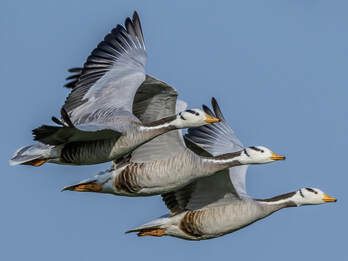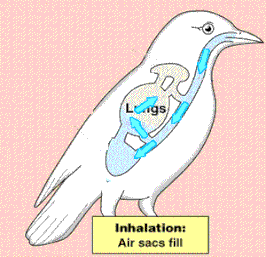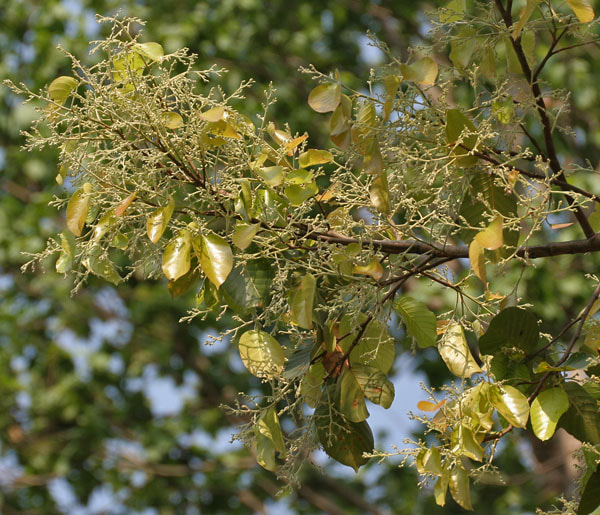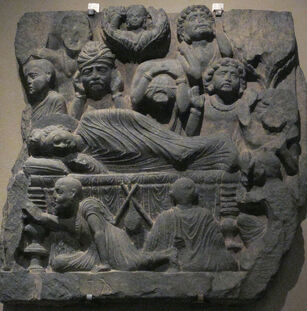|
Imagine that you’re struggling in the “death zone” on Everest, above 23,000 feet—taking one more step, gasping for breath. It’s called the death zone because once you’re up that high, you start dying; you can stay for only a limited length of time. Before this was well understood, many climbers died in the death zone.
Mammalian lungs never empty completely—a residual volume of gas always remains, and so the lungs never contain totally fresh air. This is called a “reciprocating” system. By contrast, bird lungs are “flow-through.” They don’t expand and contract; instead, birds have air sacs that expand and contract, moving fresh air through their rigid lungs in one direction.
The birds’ respiratory system makes it possible both to fly high and to fly long distances without stopping during migration. This efficient respiration also helps birds, which are warm blooded, to keep their metabolism high. They get plenty of oxygen. Birds evolved from the theropods, a dinosaur group that included such lovely beasts as Velociraptor and Tyrannosaurus. Mammals evolved from the cynodonts, a rather undistinguished, non-dinosaur reptile group. These groups had different breathing systems, which later resulted in the mammal–bird differences. What about bats, though? They are mammals, but they fly quite successfully, although not as high as some birds, nor for as long a period of time. As you’d expect, bats have several adaptations to support flight: very large hearts and lungs (compared to body size), a larger number of red blood cells than in other mammals, and more hemoglobin in those red blood cells. They, too, get plenty of oxygen. The Sherpa people of the Himalayas appear to have gene adaptations for better oxygen utilization, allowing them to perform much better at altitude than lowlanders do. As a group, they have lived at high altitudes (an average of 14,700 feet) for at least 6,000 years. For further reading:
Chase D. Mendenhall, “How Birds Breathe with Their Butts.” Carnegie Museum of Natural History. Click here “How Air Sacs Power Lungs in Birds’ Respiratory System.” July 2020. Click here J. N. Maina, “What it takes to fly: the structural and functional respiratory refinements in birds and bats.” J Exp Biol (2000) 203 (20): 3045–3064. [Note: This is a highly technical article.] Click here Emily Sohn, “The Science Behind The Super Abilities Of Sherpas.” May 28, 2017. NPR.org, Goats and Soda. Click here Jennifer Jordan, The Last Man on the Mountain: The Death of an American Adventurer on K2. W.W. Norton & Co., August 1, 2011. [The story of Dudley Wolfe, a climber who died at high altitude before the dangers were fully understood. Available at Amazon, Barnes & Noble, Thriftbooks, and probably your local library.]
5 Comments
Gautama Buddha was eighty, and he was feeling his age—he compared his body to an old cart that will move only if held together with straps. But through entering into “the concentration of mind that has no outward characteristics,” he could remain comfortable. He had decided some months earlier, at Vulture Peak, to travel back to his home in Kapilavastu, where he spent the first twenty-nine years of his life. This was a journey of some 200 miles, on foot. Now he was in the city of Vaiśālī (Vesālī), a place he had stayed often during his travels.
The next morning, Gautama rose early to beg for alms. After he had eaten, he “turned his body to the right and [while turning,] looked around in every direction with his elephant’s gaze.” He said to Ānanda, “Ānanda, this is the last time I will look upon Vaiśālī.” Gautama is saying goodbye to places he has appreciated during his life. He feels a nostalgia that many people feel as the end of life approaches. Some scholars are critical of this passage, stating that these are not the sentiments of an enlightened being. (One wonders how they would know.) Their objection makes sense only if being free of emotion, that is, feeling nothing, is a Buddhist value. I think this is an error. Buddhists are not striving to become robots; emotions are a fundamental part of who we are. Gautama was a human being with human feelings—but he was not bound by habitual patterns of reaction.†
*Quotations and descriptions are taken from Gotama Buddha: A Biography Based on the Most Reliable Texts, vols. 1 & 2, by Hajime Nakamura (Gaynor Sekimori, transl.) (Kosei Publishing Co., 2005). This is a scholarly work that uses a variety of sources and Buddhist texts. It’s currently out of print.
†For one discussion of emotions in Buddhism, see “Buddhist Insights for Accepting and Respecting Our Emotions,” by Dzogchen Ponlop Rinpoche, Huffpost, 06/04/2010. Click here.) |
Categories
All
Archives
January 2024
|





 RSS Feed
RSS Feed